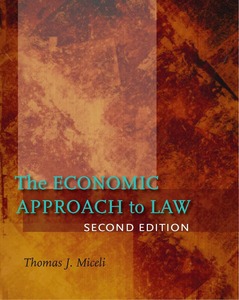Chapter 3
Applying the Economic Model of Tort Law
Key Points
• Products liability is the area of tort law concerned with accidents caused by dangerous or defective consumer products.
• Products liability in the U.S. was originally part of contract law. Under the old doctrine of privity, victims of product-related accident could only file suit against the immediate seller of the product. This effectively insulated most manufacturers from liability.
• Throughout the twentieth century, products liability gradually became a part of tort law, and manufacturers eventually became strictly liable for damages caused by defective products.
• An economic model of products liability shows that, in theory, price, quantity, and care levels will all be efficient in a competitive market equilibrium, regardless of the liability rule. This is a consequence of the Coase Theorem.
• More realistically, however, consumer misperceptions of risk and the inability of manufacturers to monitor consumer care impede the attainment of an efficient equilibrium. Economic theory suggests that strict liability with a defense of contributory negligence achieves the most efficient outcome.
• Employers are strictly liable, by statute, for injuries suffered by their employees under workers’ compensation laws. Employers are also liable for injuries caused by their employees under the doctrine of respondeat superior. This shifting of liability need not lead to insufficient care by workers if employers can monitor their employees’ actions.
• Environmental accidents present some unique problems for tort law, including multiple victims, dispersed costs, and causal uncertainty. For this reason, liability for these accidents is generally governed by a rule of strict liability under CERCLA (the Comprehensive Environmental Response, Compensation, and Liability Act).
• Medical malpractice claims are governed by negligence law, with a due standard based on “customary practice.” Further, under the doctrine of informed consent, physicians must inform patients of the risks involved in a particular treatment.
• An important question in the area of medical malpractice is whether the threat of liability causes physicians to practice defensive medicine, defined to be care beyond the efficient level.
